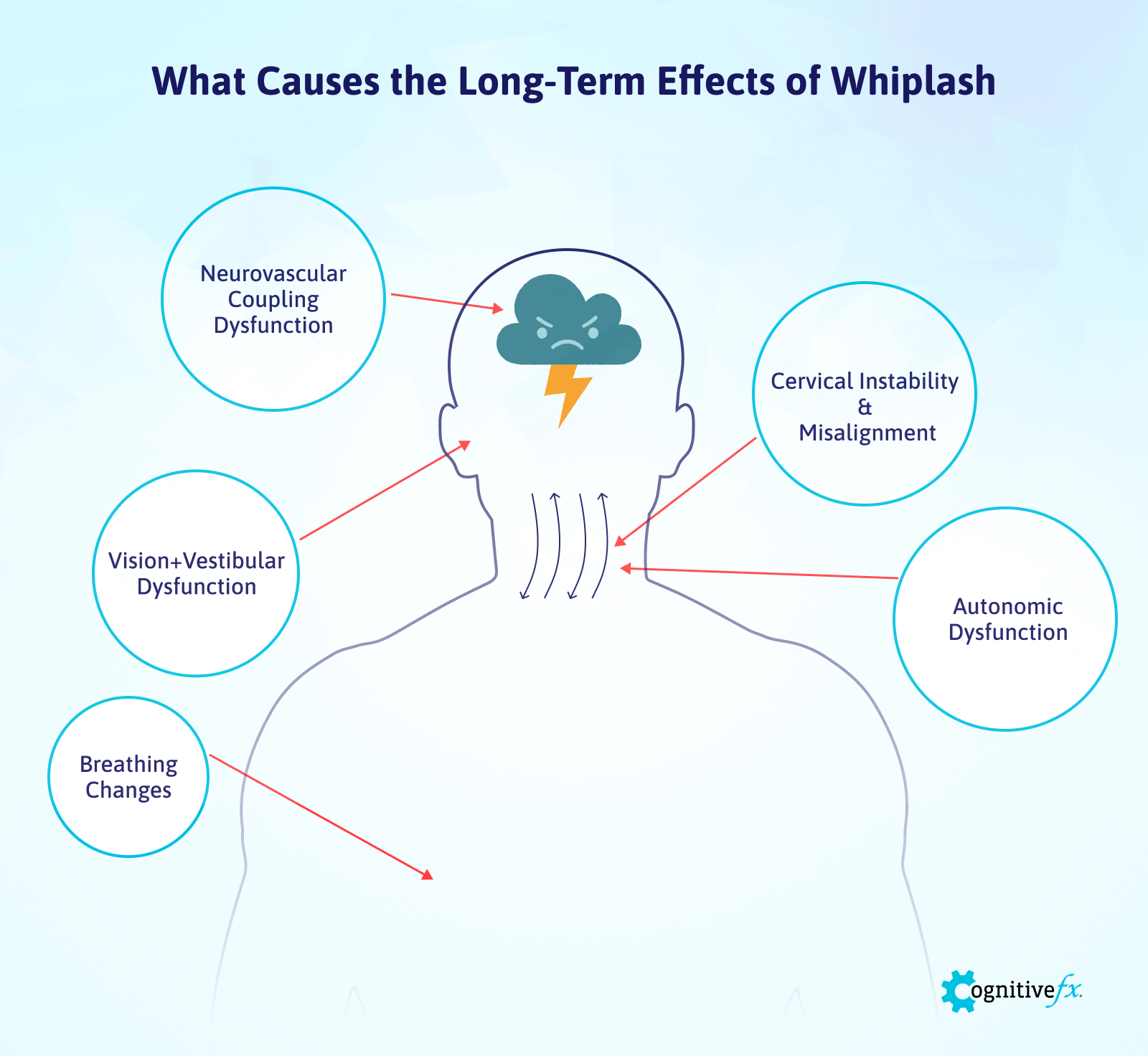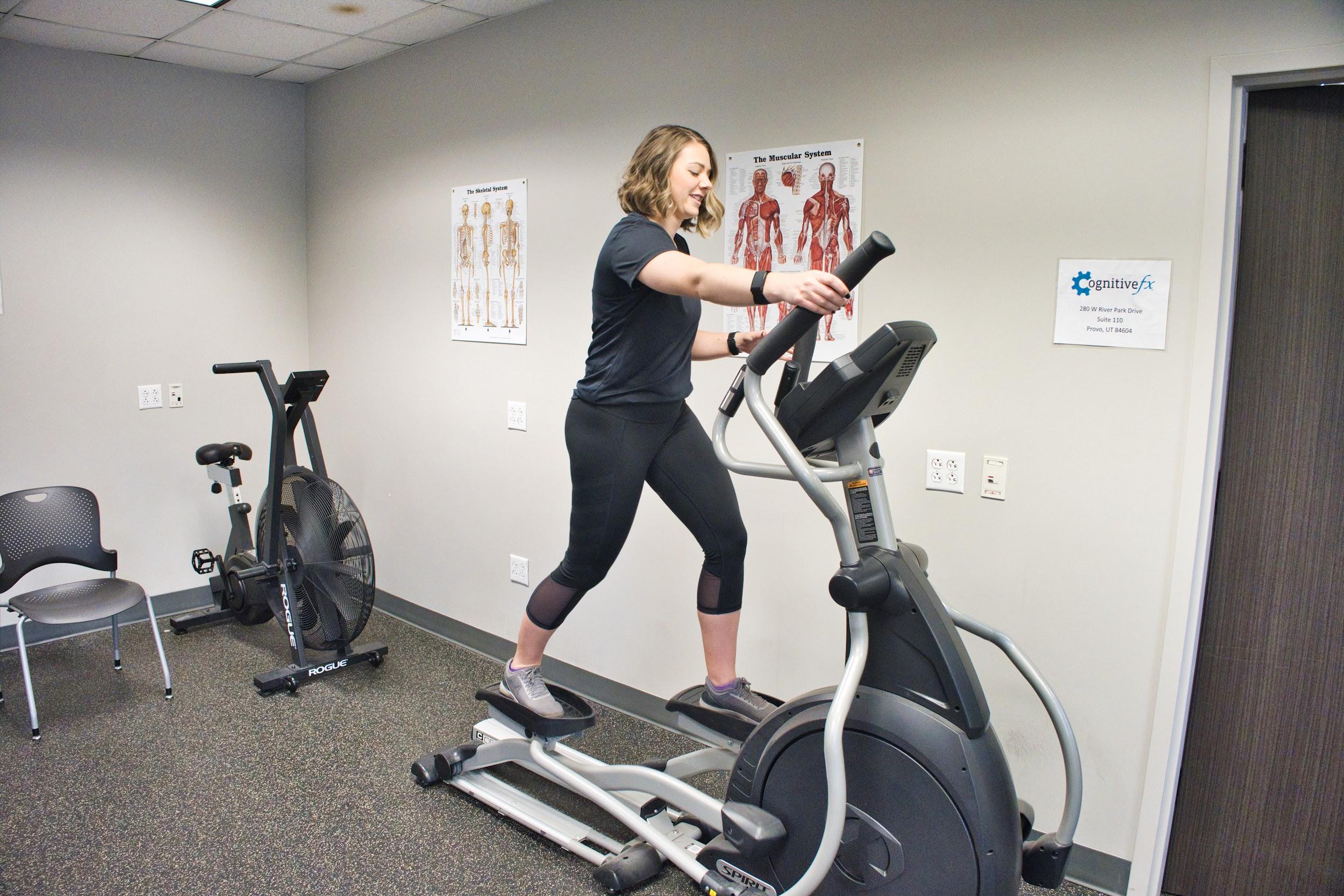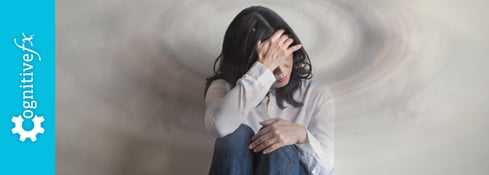How Head Injuries Cause Vertigo Years Later
Vertigo is acommonsymptom after a mild traumatic brain injury (mTBI). Most patients describe it as feeling like either the room is spinning or they are.Almost halfof those who sustain a...
Published peer-reviewed research shows that Cognitive FX treatment leads to meaningful symptom reduction in post-concussion symptoms for 77% of study participants. Cognitive FX is the only PCS clinic with third-party validated treatment outcomes.
READ FULL STUDY

If left untreated, whiplash can cause long-term symptoms that are unlikely to go away on their own. Studies show that some patients recover within the first three months after their neck injury, but if they’re still experiencing symptoms past this period, improvement is unlikely without appropriate treatment. For example, hockey player Sidney Crosby suffered for months until doctors recognized untreated whiplash. Once he received appropriate treatment, he was able to continue with his career.
Physical therapy or chiropractic care are the most common choices for whiplash rehabilitation. These treatments focus mainly on physical symptoms around the neck area, such as pain and muscle weakness. But whiplash can also result in neurological changes and symptoms. Plus, it’s common for patients who suffer whiplash to suffer a concussion also. Unfortunately, many medical professionals do not detect and treat this concussion, leaving the window open for long-lasting cognitive, emotional, and physical ramifications. As a result, many patients experience only temporary relief from their symptoms and end up returning again and again to these health care providers for the same issues.
Just ask Sam Pembleton — Sam suffered a whiplash injury from soccer that just didn’t seem to get better with physiotherapy (and then got even worse when she sustained a concussion). She visited clinic after clinic that was unable to help her before she found Cognitive FX.

Sam Pembleton’s soccer-related whiplash injury was the beginning of a search for relief that lasted over five years.
At Cognitive FX, we approach whiplash and concussion treatment differently. We offer targeted exercises to improve mobility and strengthening in the neck area, combined with aerobic exercise and multidisciplinary therapies to address the impact of whiplash and concussion on the patient’s brain.
In this article, we’ll cover:
If you’re experiencing persistent symptoms such as brain fog, fatigue, memory problems, vision changes, and more, months or years after whiplash, you’re not crazy. These are real symptoms caused by changes in the brain and autonomic system, and they can be helped. Over 90% of our patients experience significant recovery after treatment in our clinic. To determine if our program is right for you, please schedule a consultation with our team.

When you suffer whiplash — in a car accident or a sports injury, for example — you may not feel any pain straight away. Your body experiences a powerful adrenaline rush that significantly increases your pain threshold.
Under these circumstances, many people assume they didn’t suffer any major injuries and therefore don’t seek medical care. Not only could you have suffered whiplash in an accident, but the back-and-forth motion of the neck that results in whiplash could also cause the brain to move inside the skull. When that happens, it’s possible to sustain a concussion from the impact.
If whiplash and concussion symptoms are left untreated (or patients receive inadequate treatment), the injury can become much worse. Some patients develop chronic pain as a consequence of the injury. While many whiplash patients recover within three months after the injury, over half of patients continue to experience symptoms several years after the accident. Not receiving the right treatment at the time of the injury is one of the major risk factors for developing long-term whiplash symptoms.
Torn or damaged muscles and ligaments in the neck area can make it very difficult for patients to move and fully turn the neck or head. Persistent inflammation and swelling can also put pressure on nerves, causing chronic neck pain and a tingling feeling that radiates down the arms and across the upper back.
Further reading: Blog author Sylvie van de Ree describes her battle with long-term whiplash symptoms and how treatment at Cognitive FX helped her.
Not surprisingly, many whiplash patients avoid moving their necks as much as possible. Being inactive causes muscle stiffness, reduces the range of motion even further, and aggravates the pain.
Without the correct treatment, the neck pain may radiate through the back, upper shoulders, head, and vertebrae, causing intense pain and soreness that can trigger debilitating headaches or migraines, often accompanied by dizziness, nausea, vision problems, and fatigue. These symptoms can persist for months after sustaining a whiplash injury and usually require specialized medical care to resolve.
Untreated whiplash can cause more than just physical symptoms. Chronic symptoms, combined with the worry about not being able to work or go to school, can lead to depression, anxiety, PTSD, sleep disturbances, and other psychological problems. Some patients also experience cognitive issues, such as difficulty concentrating and poor memory. These conditions may make the patients more reluctant to engage in regular activities and exercise for fear of making the injury worse. This creates a vicious cycle where physical symptoms and mental health issues exacerbate each other and decrease the patient’s quality of life.
The good news is that — even if you didn’t seek medical help at the time of the injury — treatment of long-term effects of untreated whiplash is still possible. As we’ll see later in the article, at Cognitive FX, we offer a combination of aerobic exercise and multidisciplinary therapies to address the long-term problems caused by whiplash.

More than 50% of patients who experience whiplash develop persistent symptoms. Of these, severe neck pain is the most frequent, often leading to limited range of motion and tightness in the neck area. If you’d like to find out more, we’ve also covered causes and treatments for neck pain as a consequence of a concussion.
Some of the most common symptoms and signs of whiplash include:
Some patients may also develop:

Untreated whiplash is likely to cause long-term symptoms via one or more of the following:
The cervical spine is the top part of the vertebral column. It consists of seven vertebrae (C1-7), of which C1 and C2 are smaller and more mobile than the rest. Other structures located in or around the vertebrae include blood vessels, muscles, ligaments and nerves, which are properly aligned and protected when healthy.
Whiplash, however, overextends the ligaments in the neck, causing cervical instability and misalignment. An unstable cervical spine can lead to pressure against the nerves that cross the neck, interference with autonomic nervous system (ANS) signaling, vestibular and vision problems, and altered blood flow to the brain (leading to cognitive problems, headaches, and fatigue).
Under normal circumstances, brain cells receive oxygen and nutrients from a network of surrounding blood vessels. When these cells need to complete a particular task, they “request” the resources needed, and then blood vessels deliver them at the right time and to the right place. This mechanism is called neurovascular coupling (NVC).
However, studies show that patients with chronic whiplash symptoms have altered blood flow in the brain. Inevitably, NVC is disrupted, and affected brain regions may struggle to perform their tasks. Whiplash patients are more likely to experience changes in the regions involved in pain processing, leading to a lower pain threshold and explaining some symptoms like chronic pain.
Whiplash also affects the autonomic nervous system (ANS). The ANS includes two important subsections: the sympathetic nervous system (SNS) and the parasympathetic nervous system (PNS).
The SNS controls our responses to stressful situations (known as the fight-or-flight response), while the PNS has a more calming influence (known as a rest-and-digest response). Under normal circumstances, SNS and PNS work together in harmony.
In addition to many body functions, such as blood pressure and heart rate, the SNS and PNS also control the brain’s response to pain. The SNS sends out appropriate pain signals to get the body ready for action (like butterflies in your stomach when you’re nervous, for example), while the PNS is designed to calm these pain signals and to relax the body when you’re not actually hurt.
Further reading: Dysautonomia after concussion
In whiplash patients, however, the ANS is often stuck in ‘fight or flight’ mode, meaning these two systems are not working together, and they’re not sending out pain signals the way that they should. As a consequence, patients can experience chronic pain even when the body is no longer physically hurt.
Some patients experience further ANS dysregulation, resulting in symptoms such as heart rate irregularities, light sensitivity (because the ANS is involved in pupillary control), blood pressure changes, lightheadedness, and more.
The treatment program for concussion and whiplash at Cognitive FX produces an average symptom improvement of 60%. We offer therapies that most clinics do not have access to all under one roof. To determine your eligibility for our program, please schedule a consultation with our team.
After whiplash, damage to the nerves in the spinal cord can affect many functions in your body. For example, if the damage is around the fourth vertebrae (counting from the top), it can affect breathing. That’s because this area contains the nerves that connect to the diaphragm (the muscle which helps us breathe). This can cause hyperventilation, irregular breathing patterns, shortness of breath (dyspnea), and irregular heart rhythm. In turn, these changes can contribute to other symptoms, such as headaches and exercise intolerance.
Further reading: Breathing problems after a concussion
Many whiplash patients also develop visual and balance issues after whiplash. The severity of these symptoms tends to be worse if patients are also suffering from a traumatic brain injury.
Information from the eyes (vision), the inner ear (vestibular), and body movement (proprioception) are all combined in the brain to control vision and balance. If whiplash damages the nerves in the neck involved in this process, the brain may send or receive faulty information regarding position and movement.
This causes a series of symptoms such as dizziness, vertigo, lightheadedness, spatial disorientation, poor reading concentration, light sensitivity, double vision, and eyestrain.
Further reading: Dizziness after a concussion

If you need medical attention after a whiplash injury, the diagnostic process will likely include the following:
Patient History
Your doctor will start by asking questions about your medical history, such as pre-existing conditions and medication you’re currently taking. Then, they will ask about the injury and what symptoms you’re experiencing.
Physical Exam
Next, your doctor will perform a physical exam, which typically includes checking your neck for common injury signs such as tenderness or tightness, including how well you can move your neck side to side and up and down. It’s important to tell the doctor if you feel pain in the neck, numbness, or tingling in your arms or legs.
Diagnostic Imaging
Whiplash injuries are not visible on imaging tests, but if your doctor suspects you have a fracture or a severe neurological problem after a personal injury, they may order a scan to learn more. In most cases, this includes an x-ray or CT scan to detect any bone fractures or an MRI scan which can detect some damage to soft tissues, such as muscles, ligaments, and vertebral discs.
To help with diagnosis, whiplash is divided into different grades as follows:

Common treatments for whiplash symptoms usually include one or more of the following:
Medication for Pain Management
Medications are an important part of treating whiplash. There are many different types of medication that your doctor may suggest, including:
It’s important to note that these should only be used as a short-term solution to address some of the most problematic symptoms. Untreated whiplash cannot be solved with medication alone, and keep in mind that medication may also cause unwanted side-effects.
Further reading: The dangers of medications for persistent post-concussion symptoms
Physical Therapy
Physical therapy (also called physiotherapy) is one of the most important types of therapy to treat whiplash. Studies show that whiplash patients who are active and engage in regular physical activity (with the help of a therapist) have less pain and recover faster than patients who rest and avoid movement.
As soon as any suspicions of a neck fracture have been cleared, physiotherapists can guide you and teach you appropriate exercises to do safely as you recover. Some of these exercises include:
The aim is to regain range of motion, relieve some symptoms such as muscle stiffness and soreness, and restore normal movement.
Chiropractic Treatment
Chiropractors provide a non-invasive and drug-free treatment for whiplash, typically using spinal manipulation techniques (also known as chiropractic adjustments). Essentially, these professionals identify the neck joints that are misaligned after whiplash and position them back into their proper place. The aim of the treatment is to:
Typically, patients need more than one visit to a chiropractor. Although this treatment may help for a few days, symptoms tend to come back, and patients need to be readjusted again. There are also many reports of patients receiving inadequate treatment from chiropractors, which highlights the need to find a chiropractor specializing in whiplash treatment.
Osteopathy
Patients who suffer from whiplash may also seek the help of osteopaths. Studies show that treatments used by osteopaths can help relieve neck pain and other health conditions that develop after a whiplash injury.
Techniques used by these professionals range from soft tissue massage to joint mobilization and manipulation techniques, which alleviate pain, relax muscles and reduce swelling. Osteopaths can also suggest some physical exercises to boost the benefits of the treatment, allowing the patient to recover faster.
Acupuncture
Using acupuncture for whiplash-associated disorders can reduce pain, inflammation, and tension. It also decreases swelling and helps relax soft tissues.
Acupuncture alone is unlikely to cure whiplash, but it can help alleviate pain. Other types of treatment (such as PT and chiropractic care) are more likely to be effective following acupuncture.
Massage Therapy
Neck and back massage can provide short-term relief from neck pain. A massage therapist can use different techniques to help whiplash patients, including trigger point therapy to address painful areas and increase range of motion, compression to promote blood flow to the area, and deep tissue massage to relax muscles. Massage therapy alone is not enough to treat whiplash, but it can be combined with other options, such as physical therapy or chiropractic care.

Although many of the treatments described above can help lessen symptoms, they are often not a full solution for the long-term effects of whiplash. Patients may need to combine various options and visit different providers, which delays and complicates recovery.
In addition, some of the treatments may not be the most appropriate for whiplash patients. For example, some chiropractors readjust C1 (called atlas) and C2 (called axis) vertebrae. Any damage to this area limits range of motion, affects posture, and blocks communication between the nervous system in the brain and the rest of the body. For this reason, manipulations in these vertebrae need to be very gentle. If you visit a provider with limited experience in whiplash injuries, the treatment you receive will either not reach the affected areas or it may be too forceful, causing further damage. We have even seen patients who suffered a concussion because of their chiropractic adjustment.
Even if you visit an experienced chiropractor, it is likely that you’ll need multiple visits. Treatment may provide some relief for a few days, but symptoms often return. That’s because the underlying issues are not rectified by the adjustment. The vertebrae can easily be pulled out of alignment by post-injury muscle tension or instability. Fortunately, these conditions can be corrected by appropriate therapy.
In contrast to common treatment options, Cognitive FX offers a combination of aerobic exercise, multidisciplinary therapies, and mobility and strengthening exercises to address the symptoms of whiplash (and often concussion) as a whole. We do not offer spinal manipulations as part of our treatment. We focus on retraining motor control so that the body adopts healthier positioning and motion without needing to be consciously corrected.
Evidence shows that this approach can be very beneficial for patients. For example, a study combining physical exercise, occupational therapy, and psychotherapy found that six months after the treatment, over 90% of chronic whiplash patients had returned to work (at least part-time), and 80% of patients didn’t need any further medical care. Most patients reported significant reductions in pain, as well as fewer cognitive and psychological problems.

There are occasions when we refer patients to a trained chiropractor with experience dealing with whiplash cases. We believe using chiropractic techniques to ensure the neck is properly aligned (if needed), combined with our therapy regimen, is the best approach for whiplash patients. This method improves both physical and neurological symptoms, avoids multiple visits to the chiropractor, and speeds up recovery. It’s important to note that having this option doesn’t mean we want our patients to see a chiropractor before they start treatment with us.
If you’re suffering from chronic whiplash, schedule a consultation at Cognitive FX, and we will guide you on how to proceed with your treatment. Some patients may need to see a chiropractor or other healthcare professionals, while others don’t.
In addition, as many patients with whiplash also suffered a traumatic brain injury, our approach also addresses this condition. We are experts at treating post-concussion syndrome (PCS), which occurs when patients experience concussion symptoms for months or even years after injury.
Before treatment, patients must complete a detailed assessment to determine how whiplash has affected their brain. Our team will ask about symptoms and medical history, as well as conduct a series of physical, cognitive, and psychological tests, including:
Patients also undergo a brain imaging scan called functional NeuroCognitive Imaging (fNCI). This scan assesses about 100 regions in the brain and how those regions communicate with each other while the patient performs a series of standardized cognitive tasks. After this initial assessment, our team gathers all the information and designs a treatment plan customized for each patient.
For many patients, seeing their fNCI scan results is a moment of release. Tangible evidence — in contrast to doctor’s visits where they weren’t taken seriously or weren’t helped the way they needed — plus a concrete action plan, makes all the difference.
“No one was ever able to tell me anything concrete before then,” said Cognitive FX patient Chris Nicastro. “It was super validating to see there was actually a physical discrepancy in my brain.”
Treatment typically involves a three-step cycle that is repeated throughout the day: Prepare, Activate, and Recover.
Step 1: Prepare
To prepare for therapy, patients engage in a short session of aerobic exercise. This improves blood flow to the brain and triggers a mechanism in the brain called the post-exercise cognitive boost (PECB). In turn, PECB promotes the release of a chemical called brain-derived neurotrophic factor (BDNF), which stimulates the growth of brain cells and improves communication between different areas of the brain. The aim is to make the patient’s brain better able to benefit from subsequent therapy. There is also some evidence that aerobic exercise can reduce neck pain in patients with whiplash. This effect is called exercise-induced hypoalgesia.
Often, patients have not been engaging in regular exercise before coming to the clinic. Our therapists will help you through any difficulties and symptoms you experience. Patient Quirien Willemsen describes what this step is like:
They had this tailor-made program for me, and the first thing I did was get on a treadmill. But after a couple of months doing nothing, I had no energy, no stamina. But they had a trainer standing next to me. When I got off, we did some breathing exercises, and it was all good after that. Whenever I had a question, they were up for answering it, but also in a way that was easy for me to understand.
Step 2: Activate
For the next step, patients engage in a series of multidisciplinary therapies, including:
Most patients receive all or most of these therapies during their visit, but the exact exercises are specific to each patient. For example, patients with whiplash need more neuromuscular therapy along with targeted mobility and strengthening exercises. In addition, these patients typically engage in vision and vestibular therapy at the beginning of treatment to improve mobility and stability, which then allows them to take full advantage of subsequent therapies.

A Cognitive FX therapist demonstrates an exercise for neurointegration therapy.
Step 3: Recover
The final step involves periods of rest and relaxation. Patients may practice mindfulness, receive a neck and shoulder massage to relieve tension, or relax in a dark room while listening to an app that creates binaural beats. The app produces two close-but-not-the-same sound frequencies that the brain averages into one frequency, which encourages the brain to rest in a manner similar to meditation.
At the end of treatment, patients go through a second scan to see how much their brain has changed. Patients also meet with a therapist to analyze their results and receive a series of exercises to do at home. This homework typically includes physical exercises, cognitive activities, and relaxation techniques, and it’s one of the best ways to promote recovery at home. It takes about one hour four to five times a week at first, but patients can reduce the time as symptoms improve. In addition, if our therapists feel that patients may benefit from further therapy, we recommend suitable specialists.

In our experience, patients who suffered whiplash and a concussion can take a little longer to recover than if they had just a concussion. After therapy, many patients notice improvements in symptoms like fatigue or brain fog but still have problems with the neck and back. However, with continued treatment, we believe full recovery is possible for most of these patients.
To determine if our program is right for you, please schedule a consultation with our team.

Andy is a Certified Athletic Trainer (ATC) and Z-Health Performance Master Trainer. He began his career in Orthopedics, then worked as Head Athletic Trainer and Director of Human Performance at a specialty physical therapy clinic. Here, his passion for innovative human body approaches ignited. In 2010, he founded Fitness Evolved in Berkeley, CA, focusing on a neurologically informed health and exercise paradigm. Andy mastered the Z-Health Performance Solutions system, creating brain-centric training and rehab at Fitness Evolved, serving diverse clients, including pro athletes and brain injury survivors. He's an accomplished Z-Health instructor, having trained professionals worldwide. Andy is thrilled to join Cognitive FX, contributing to our revolutionary concussion and TBI recovery techniques.

Vertigo is acommonsymptom after a mild traumatic brain injury (mTBI). Most patients describe it as feeling like either the room is spinning or they are.Almost halfof those who sustain a...

Whiplash can cause physical and neurological damage that results in long-term symptoms. In addition, the same event that caused whiplash could also have caused a concussion. (The sudden motion can...

If you’ve started getting headaches after you’ve suffered whiplash, you’re not alone. After neck pain, headaches are the second most common symptom from whiplash. Over 60 percent of patients have...

If you have post-concussion syndrome (PCS), then you likely know how difficult it is to get an accurate diagnosis and comprehensive treatment. Many medical doctors don’t have the resources to treat...

After headaches, dizziness is the second most common symptom patients experience after a concussion. Although this symptom often resolves by itself, it becomes persistent and debilitating for some...

If you’ve been diagnosed with Postural Orthostatic Tachycardia Syndrome (POTS), you’re not alone in wondering when or if things will get better. For some patients, it’s a temporary condition that...
Published peer-reviewed research shows that Cognitive FX treatment leads to meaningful symptom reduction in post-concussion symptoms for 77% of study participants. Cognitive FX is the only PCS clinic with third-party validated treatment outcomes.
READ FULL STUDY